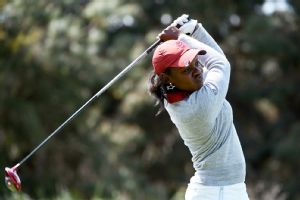GB AND I PRE-MATCH PRESS CONFERENCE AT ST LOUIS, MISSOURI
THE MODERATOR: Thank you for
joining us. We have Captain Tegwen Matthews of the GB and I Team and
Stephanie Meadow and Annabel Dimmock. It's been a lot of lead‑up for all
of this. Tell us how you feel to finally be here in St. Louis and ready
to compete.
TEGWEN MATTHEWS (pictured): Very excited and
really can't wait for tomorrow now. It's been ‑‑ I don't know quite
know where the two years has gone from then, but then landing in Atlanta
last week, that went very quickly. But it was a great bonding with the
team and it gave us a very good acclimatization for the heat and
humidity, which we haven't had today but we have had and had to cope
with it. So, yeah, we are ready to go.
THE MODERATOR: Stephanie, you've
played on a team before, had the opportunity to win before. How do you
feel coming into this week kind of being one of the veterans on the
team?
STEPHANIE MEADOW (pictured): Old (laughing).
No, definitely, it's great to have that experience behind me. I can
pass things on to the girls. Hopefully I can be a lead for them. I
think it gives us confidence.
THE MODERATOR: And Annabel, your
first time experiencing something like this. Tell me what the whole week
so far ‑‑ and you've already been with the team for two weeks, so what
the last two weeks has been like?
ANNABEL DIMMOCK (pictured below): The last two
weeks, the first week was great. I really enjoyed myself. I didn't know
Steph
before and I didn't know Charlotte before but we got on
really well.I feel I've known them just as long as
the other guys now, which is great. But yeah, I'm really excited.
Q. I wanted to ask you, you
played on other teams, as well. I think that you were able to win last
time ‑‑ and the record is very lopsided there. But once the European
side started winning The Ryder Cup more often, it became a much better
competition, bigger deal. Do you think that that could be the case with
the Curtis Cup? How important is it that you guys were able to win last
time?
STEPHANIE MEADOW: Definitely, it was huge. For it to be
in Scotland and we had huge crowds. I think we broke records.
To just be able to promote (women's amateur) golf back
home is great.
I think for us to win, it might
inspire some more of our girls back home to get more into the game. But
this has always been such a prestigious event. It's a friendly rivalry
and it's something that they have all worked so hard for. I wouldn't
change anything.
TEGWEN MATTHEWS: I think
winning at Nairn, we had a huge impetus there with the home crowd but we
really had an awful lot of support prior to that. We did a lot of sort
of getting people engaged on Facebook and Twitter and myself, you know,
from about four months out, I was posting loads of things on Facebook
about how the preparations were going and how the girls were doing. That
is actually how an awful lot of people communicate now.
People do a lot of things via
Facebook or Twitter, and then as a result, even now, when we're here in
America, the support on Facebook and Twitter that we are getting from
everybody at home makes me feel like it's almost a home match. So you
recognize that as an important medium how to reach people, and it's been
great fun, yeah.
Q. Do you agree that aside from personally wanting to win, but going forward is that a great thing for the Curtis Cup?
TEGWEN MATTHEWS: Oh, for sure. I think so.
Q. For one side not to dominate.
TEGWEN MATTHEWS: I think it's
important, otherwise it just becomes ‑‑ oh, it's just another match and
it's the USA always win and you're not going to get any kind of
enthusiasm from the girls back at home to aspire to being the very top
of their field in amateur ladies golf, which could be culminating is
playing in a Curtis Cup team.
Now it feels as if that result in
Nairn has had a good effect on girls getting on the team and even the
girls I've got with me now, it's a very different team. Six of the team
are completely different girls.
And you just take someone like
Annabel, two years ago, where were you? Not at Nairn. That itself is an impetus,
showing that Annabel is here now today; maybe as a result of the Curtis
Cup win at Nairn, maybe not. But certainly having the high profile of winning a
Curtis Cup made a huge difference in British golf.
Q. You won back home last year, but to win on U.S. soil would it mean even more to win here?
STEPHANIE MEADOW: Definitely. I think in any sport it's always
harder to win away from home. I think to win on U.S. soil, so ‑‑ see,
this is the thing that's very different this year I think; that we have
four girls on the team that are at US colleges now.
So it's not as if a lot of us are
not very comfortable here. A lot of us play American golf all the time. Annabel played successfully on the Orange Blossom Tour in Florida in January.
So I think that's a big advantage that we have compared to years in the past.
So I think that's a big advantage that we have compared to years in the past.
But it's always exciting
to win away from home, and the supporters that we do have here, which is
actually quite a few. A lot have made a long trip to come follow us,
and for us to win would be really special for them.
Q. I'm going to stereotype and
say for St. Louis, the Curtis Cup is a learning experience and none of
us know tomorrow how many people will show up for this event. Would it
be fair to say from your own experience when you played in your part of
the world generates a little more excitement than you experience when
you played in this country?
TEGWEN MATTHEWS: I think when you go back to many years ago when I
did play in Curtis Cup, that was certainly the case in my first Curtis
Cup in San Francisco. There were hardly any spectators at all there. Apawamis at Rye, New York, was my other away game in the Curtis Cup. There weren't many spectators there, either.Depends obviously on the venue in the U.K. but generally I think you're probably right, yes, it does generate more. I don't quite know where that is, other than the fact America is a big country and a lot of people would have to travel.
Q. You haven't had this team together before until just recently, right? What kind of factor does that play?
TEGWEN MATTHEWS: Well, if you
look at it on paper and you go, okay, that's a strange thing. For
instance, it's the first time I've flown out of the U.K. with only half
my team and the other half already being in America. So that sort of
felt a bit strange, normally we would have all travelled together out
of the U.K.
As Steph said, the fact that there were
four of our girls already here, it's not only comforting for me; it's
comforting for the rest of the girls, because we have got loads of
experience in those four girls who can tell us what it's like and what's
normal and don't eat those sweets and do eat these sweets and all those
silly little things that make a difference.
It's different but it's not a disadvantage in any way.
Q. You practised in Atlanta?
TEGWEN MATTHEWS: Yes.
Q. Can you talk about where you practiced and what you did and why?
ANNABEL DIMMOCK: So we got there,
the first day we played, just like getting the cobwebs out. The course
was really good. It was tough. I found it tough playing the first day
because I was tired on the course, obviously with the jet‑lag. I just
found the course was really weird, different, the grass and the greens. Even my yardages are different out here.
We just practised the second day and the third day we practised in the morning and then we played the par 3 against the juniors in the afternoon which was really good fun. We met some really good little players actually. We played with them around the par 3 course which was really good.
We just practised the second day and the third day we practised in the morning and then we played the par 3 against the juniors in the afternoon which was really good fun. We met some really good little players actually. We played with them around the par 3 course which was really good.
Then the next day, we played the
men, like the male members at the club there, 36‑holes match, which was
really good. It was really tough, as well. They had actually really good
players, didn't they. I played like an ex‑pro and he was really good to
play. It was good, like pressure match. I thought it was
good preparation.
TEGWEN MATTHEWS: And experiencing
the full heat and humidity and the full storm, because I think you
played about 12, 13 holes in the afternoon and you could see the clouds
coming over and wallop, it came down.
Prior to that it had been very
hot, very humid and all of a sudden, whoosh. It was a good grounding to
what you can expect even here I guess.
Q. Where was it?
TEGWEN MATTHEWS: Atlanta Athletic Club.
Q. For both of you as players,
Atlanta Athletic has this unique fairway grass, the Diamond Zoysia;
almost a perfect playing surface and this course (at St Louis) is true bentgrass. As
you practise this week, have the playing characteristics coming off the
fairway been pretty much the same as you experienced at Atlanta
Athletic?
TEGWEN MATTHEWS: Well, my home
club, the West Course is bentgrass. It's literally like this, but not as
green. So I'm really used to that and the greens here I like. But the
greens at Atlanta Athletic Club were Bermuda, which I found different.
STEPHANIE MEADOW: The fairways
are very similar, same thing and they a lot of the same grasses in
Alabama. I know at Atlanta Athletic Club they had some problems with the
zoysia, they had to re‑seed a lot. Some of the fairways were a little
rough but other than that it was great.
Q. What are your impressions of this course?
STEPHANIE MEADOW: I think as far
as all of us being together ‑‑ yeah, two heads are always better than
one. Just at the start of the week we played in twosomes and did our own
thing and came up with our own game plans and especially today we
talked through some stuff and just tried to get people's opinions. The
golf course, it's in fantastic condition and the greens are great. I
think the hardest part about this golf course is the greens. Tee‑to‑green, approach shots are not too bad.
But positioning yourself in the
right part of the green is important. Having as many uphill putts as you
possibly can is important. The staff here have done a tremendous job
and it really couldn't be any better.
ANNABEL DIMMOCK: I really like it. I like how every hole is different here. I really
like the fairway undulations. I think it makes the course interesting.
It's not like a flat fairway to aim for. There's different parts on the
fairway and you can get different bounces.
It's cool, because like you can
hit two shots out there and they can bounce off different part of the
fairway and you can go to different parts of the fairway. So that's
good. Makes a difference.
Q. Players at your level have
played collegiate and match play, but you're also playing partner golf
and there are not that many opportunities. How much history playing
four‑ball and foursomes? Just comment on the two formats as you
experience them.
ANNABEL DIMMOCK: I played in the Girls and women's home international matches back home
last year which is foursomes in the morning and then singles in the
afternoon. So there's a lot of that. But we don't play that much match-play,
really. But then once you turn pro, you don't really play match-play either apart from Solheim, obviously if you're lucky enough to get in.
But no, I really enjoy it because I really like being part of a team. I love it, so I enjoy that part of it.
What was your second question?
Q. If you're playing
alternate‑shot, you can destroy a friendship or build a friendship
depending how it goes.
ANNABEL DIMMOCK: It's good to
play with like a close friend in foursomes so that you almost don't feel
obliged to say, "I'm sorry." Like that's the worst thing on the golf
course; you shouldn't have to say that.
Yeah, I think the whole of our team is quite close
TEGWEN MATTHEWS: Toughest
decision I had to make was who not to play. With regards to who
could play with who, quite honestly from top to bottom, I could have put
any combination. With foursomes, I totally agree.
I think you need to be with
someone you are absolutely comfortable with, and we had a big long
discussion last night and the night before that, and we are in total
agreement with who is going to be with who out there, and that's it.
Q. Did you let the players decide who they were most comfortable with?
TEGWEN MATTHEWS: Yeah, we did. We
had a full open discussion. It's actually totally refreshing to me to
have a team as brilliant as this that we could have that open
conversation with, that no one was afraid to say what they felt or what
they were more comfortable with.
Q. Why do you think that is?
TEGWEN MATTHEWS: I don't know.
It's kind of strange, because all these girls are young, so you would
think it would be something that would come from more maturity, but no,
not necessarily. Certainly wasn't the case in my day. You never said boo to a
goose in my day; you did as you were told.
You know, that's the difference in life now. These girls are very
confident, and they are very open, and I love all that. I love the fact
that they can be. It makes my life an awful lot easier.
STEPHANIE MEADOW: I think we
respect each other, too. We respect each other as great players, and
it's not like, oh, I don't want to be with her.
ANNABEL DIMMOCK: There's no one on the team that you would be like,
no, I don't want to be with them. Everyone is a good player here.Q. You're probably more familiar with the American Team in some respects; is there someone that you didn't really know before this week that you were really impressed with their game at Atlanta Athletic Club that you could share with us?
STEPHANIE MEADOW: I didn't know
Annabel at all. I don't think I ever saw her before. I was very
impressed. She hits the ball great. She's a great player, good putter.
It's nice to not know someone and then ‑‑ oh, she's good.
And also, Charlotte is over here,
too, but I had never met her ‑‑ I had met her at national college tournaments but never
seen her play before. Very steady, very accurate
TEGWEN MATTHEWS: Two of our American college girls, Gemma and Charlotte, we had a discussion at dinner where
they said, we have never, ever played with Steph who is also on the US women's circuit.
STEPHANIE MEADOW: It's weird. I don't know how many times we played through the season but a lot.
Q. Do you anticipate you'll have a player play in every session?
TEGWEN MATTHEWS: Yes, I do.
Q.
And when you get to the Sunday singles, is that still a blind draw or
do you ‑‑ when the captain's put together their lineup, that's blind;
you rank your players and they rank the players. The Presidents Cup has
gone I think to a format where the captains have actually informed
decisions to make. Would you be in favor of a change of that sort,
instead of just take whatever comes?
TEGWEN MATTHEWS: Don't really
know the answer to that. I'd have to sit down and think about the pros
and cons to it. Don't really know.
I mean, I'm quite happy just
putting the team in. I don't believe in the jigglyboo (ph). You can
second guess me until doomsday, but I'm going to put people where I
think they should be at any one time. I'm very lucky to have a team from
top to bottom who are very good from top to bottom so I don't have to
worry about strength at the top or strength at the bottom.
Q. The selection process?
TEGWEN MATTHEWS: I think it has
been refreshing. I think it's provided complete clarity to the players
in knowing what they needed to do to get onto the team, and to their
parents and to the coaches and to the national organizations.
Labels: CURTIS CUP














 MARIAH STACKHOUSE. Picture by Donald Miralle/Getty Images
MARIAH STACKHOUSE. Picture by Donald Miralle/Getty Images
 Staffordshire’s
Julie Brown will bid for a rare double when she tees up in the English
senior women’s stroke play championship at Knaresborough, Yorkshire,
from June 17-19.
Staffordshire’s
Julie Brown will bid for a rare double when she tees up in the English
senior women’s stroke play championship at Knaresborough, Yorkshire,
from June 17-19.